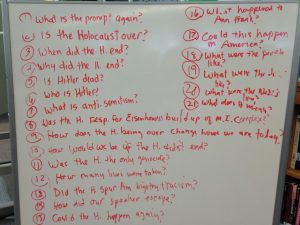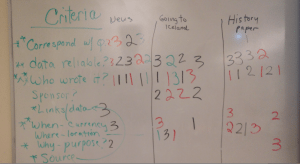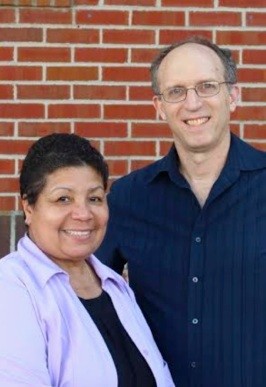When first starting to use the Question Formulation Technique (QFT), I thought I needed to run through the process as described each and every time. It made sense, after all, to complete it with fidelity so that I would know that I was doing it “right.” As I became more competent – and confident – in using the process, I realized that the process had become ingrained in my own teaching so much that I wasn’t even thinking about it as a ‘formal’ process any more. I began to see how important it is to teach the process, and then continue to use it until it becomes a big part of how we interact with our learning environment. Here then are my most recent “ah-ha” moments with QFT:
- Use QFT on the fly
- Use QFT as a way for students to formulate their own criteria for questioning things.
- Have students put QFT into their “back pocket” to pull out when needed
- Help to create a questioning school environment through informal PD
- Don’t forget to reflect
- Use QFT on the fly
Imagine this scene: there are 5 classes of kids rather stuffed in the library after lunch one day. We are all awaiting our speaker, a Holocaust survivor visiting our school to share her story. She is late. After about 5 minutes, it dawns on me that I perhaps mis-communicated the time; and I had a reasonable idea of when she’d get there – in about 20 minutes or so. What to do? Send them back? Not likely, since once they’d get back to class most teachers would just stay and start on other work.
So… what would any reasonable librarian do? Begin a dialog. How? QFT.
Thinking quickly, I designed a QFocus, that would hopefully get them thinking about questions they might like to ask our speaker: The Holocaust is with us today.

150 students, their teachers, and I went through the QFT process (I had the rules posted as a bulletin board in the library)– with the idea of creating questions they might like to ask the speaker. It took a bit to settle in, but after they saw that this was part of their lesson for the day, they got into it, with some showing their knowledge (“Was the Holocaust responsible for Eisenhower’s build-up of the Military Industrial Complex?”) as well as those jokers (“what was the prompt?”). By question 9 or 10 or so, they began to think about the topic in terms of the upcoming speaker and started asking questions that had meaning for them.
Our speaker showed up 20 minutes later to loud applause, just as we were identifying open/ closed ended questions. Later, using the board as prompts for their questions, students asked far more in-depth questions than they might have without going through this process.
I am certainly glad that I have an excellent strategy that is not only a fabulous in-class daily skills builder, it is one that I can pull out of my proverbial ‘back pocket’ (under duress!) and create a focus for learning with a restless crowd of 9-11th grade students.
- Use QFT as a way for students to formulate their own criteria for questioning things.
Working with students to identify what kind of information source will help them accomplish a research task can sometimes be tricky. In times past, I’ve handed out rubrics for them to follow that ask them to locate specific criteria, but I noticed that it was becoming an activity of mostly filling in the blanks without any thought behind it. Using QFT, I switched it up and asked them to choose their own criteria. Here’s how it worked:
After studying the different kinds of sources (scholarly articles, newspapers, popular journals, diaries, etc.) available to researchers, I put this QFocus up on the board: Three things you look for when deciding if a news (or other) source is useful.
With partners, they asked questions about the QFocus.
Why only three?
How do we define ‘useful?’
Does ‘useful’ relate to what I need to know?
Is author one of the criteria?
How about date?
Does data matter?
Expanding their partner base from two to four, students changed them to open and closed ended; and prioritized them according to the top three that exemplified criteria by which they might judge usefulness. Before going further, we discussed a definition of ‘useful’ with the students concluding that ‘usefulness’ was any resource that could be used to answer the research question either as evidence or knowledge-building. We then discussed that as researchers, while we must create our own research questions, it is our job to question those resources we use to determine if they can provide us with the information we need to answer our research questions.
Using a scenario of: you are planning a trip with your family to Iceland. What resource(s) will best help you create the best journey ever? Students in their groups identified their top three resource criteria first:
What questions do I need to ask of my resource?
A) does it correspond with my research question?
B) does the data look reliable?
C) who wrote this thing? Who sponsored it; who links to it?
D) when was it written? Is that important?
E) why was this created – what’s its purpose?
 After setting the criteria – all of which are normally included in any list I give to students to fill out (they did this on their own!) – I gave them three source types: a newspaper, a travel website, a scholarly journal. With their partners, their job was to determine which criteria, for this assignment (info for a trip), needed to be number 1 priority, number 2, and then number 3.
After setting the criteria – all of which are normally included in any list I give to students to fill out (they did this on their own!) – I gave them three source types: a newspaper, a travel website, a scholarly journal. With their partners, their job was to determine which criteria, for this assignment (info for a trip), needed to be number 1 priority, number 2, and then number 3.
It’s easy to see that except for the “who wrote this?” question, groups varied in their opinions on what is considered to be important when determining the usefulness of a site. All agreed, however, that in order to determine what to do/see in Iceland, a scholarly article (or history site) is not as useful as up-to-date targeted information.
What made this activity different from the way it had been done in the past was to allow students to not only determine their own criteria, but to help them to see that asking questions isn’t just about what they need to know… it’s about asking their information more about itself. This is a big step in the process of understanding how to relate to news today as well as how to determine if any particular piece of information (a data table, an article, a website) has the clout, authority, currency, and evidence needed for information gathering.
Using QFT here, was not as ‘formal’ as is often used because these students knew the format and my goal was to help them get the content but also to reinforce the mindset of question-asking. By using QFT verbiage (its “terms of art”), students conversed easily about the process: “don’t we just want a closed ended question here? I mean, we just want to know who wrote this thing!”, stated one student. Taking the time to let students create their own criteria through questions lets them take ownership for the ‘scholarly conversation’ they are having with their resources.
- Have students put QFT into their “back pocket” to pull out when needed
In an earlier blog post I mentioned meeting up with students on the fly who wanted information about how to know if a website or other resource was reliable. We didn’t have much time and they wanted easy answers. But information reliability is a complex puzzle and there is no single “right” path to figuring it out. By giving the students a quick run-through on question building, they were able to identify the key points they wanted to know as they looked over their debate information. Teaching them the “quick and dirty” way to identify open/ closed questions and when to use them to get the kind of answers they want gives them skills they can use when faced with debate or needing to decide which sources that pop up in their browser will be best to use.
- Help to create a questioning school environment through informal PD
When meeting with colleagues to craft goals, objectives or other actions for things such as accreditation, or a grant application, informally inserting QFT into the process can kick-start brainstorming. Informally suggesting that we first list some of our questions together and then prioritizing them helped our small work group to create a working start to a digital citizenship curriculum that we were tasked to create. Still a work in progress, the big picture is laid out and the group can now move forward to identify the component parts and create lessons that articulate together well.
- Don’t forget to reflect
Whether it’s in an ‘exit card’ (what did you learn today?) or a class discussion, or a journal entry, reflection is an important way for us all to determine what will stick with us and what will most likely disappear.
While there will always be times when going through the formal QFT process is the best way to approach a task, once I’ve taught the QFT process to a class, we are able have a conversation that centers around the language of questions by just jumping into the task at hand. We can move quickly to prioritizing or identifying if a question is better served by changing from open to closed or stop for a moment and devote 5 minutes to brainstorm if we’re stuck on something. And, because I’m a librarian and my tasks with students usually includes how to answer those questions, by having the QFT process in “our back pocket” students have been able to elevate their research queries to a deeper understanding of how to “talk” with our resources because they know that they will find the right questions.
When asked if this process was valuable to them:
“I value [the QFT] because it helps me think deeper about the questions I’m asking.”
“It helped me go deeper into the topic of my project than just answering a simple, closed question.”
“Now I have a better understanding of research topic questions and how to find a question.”
“Now I can elaborate on my question and do quality source finding.”
“Today I learned how to alter and improve my research question. This has already helped my research question become more manageable and fit within the requirement of the project better. This helped me zero in and pinpoint which section of my topic I am truly interested in.”
 Connie Williams spent 28 years as a teacher librarian for Petaluma City Schools. She now works as an adjunct for Santa Rosa Junior College and an on-call librarian for Sonoma County Libraries. She recently published “Understanding Government Information: A Teaching Strategy Toolkit for Grades 7-12.”
Connie Williams spent 28 years as a teacher librarian for Petaluma City Schools. She now works as an adjunct for Santa Rosa Junior College and an on-call librarian for Sonoma County Libraries. She recently published “Understanding Government Information: A Teaching Strategy Toolkit for Grades 7-12.”




Now I understand why the classification of questions is important and the relevance of making pupils think about the criteria of classification or questioning things. I think it may be an “easy” way to make pupils responsible.